EBOOK
How to Write Product Descriptions
Published: Aug 4, 2017

What you’ll get from this guide
Product pages come at the ‘pointy’ end of the customer journey, and it’s here that the choices you make as a marketer – and in particular, the product descriptions you use – can have a huge impact on whether or not a page converts.
You should therefore lavish just as much care and attention on writing descriptions as you do on your ad or email copy – it’s here that your customer will evaluate whether what you’re offering is really what they need or want.
In this e-book, you’ll learn how to become a top-class e-commerce copywriter, learning: why product descriptions are worth your time, how to write them, what good description examples look like and how to optimize a product page for SEO and CRO. So let’s get started.
Why product descriptions matter
Words matter. That’s why email subject lines have become a fine art (that even demands the attention of presidential campaigns) and why it takes weeks of fine-turning to perfect a PPC ad.
But do you spend as much time thinking about what you write about your product? Here’s why your product descriptions deserve that attention:
They sell your product
It sounds obvious, but it’s worth repeating: compelling product descriptions have the power to convert.
Product descriptions need to create an emotional response in the reader – urgency, scarcity, excitement, how much easier their lives will be once they’ve bought this product.
Marketing Experiments, a marketing research organisation, gives an example that demonstrates the importance of the product description over other forms of sales techniques:
Running four different versions of a product page for an eBook, the seller used security seals (Version A), information on device compatibility (Version B), the book’s synopsis (Version C) and the assurance of quick accessibility upon purchase (Version D).
Version C, the book’s synopsis had by far the greatest impact, generating a 78% relative change in conversion.
This the last, crucial sales pitch after hours (and dollars) of hard work getting your visitor to the point of purchase. Product descriptions are your make-or-break copy.
They communicate to your customers
An e-commerce copywriter needs to perform the job of a bricks-and-mortar salesperson, giving the visitor the kind of information that will assist them in making an informed decision to purchase.
According to a recent study from Salsify, 94% of customers will abandon a site if they can’t find the information they need to make an informed purchase, so it’s important that your product description provides all the necessary details. Furthermore, even if the visitor converts, 70% of returns are still because the size or colour is wrong, so it’s crucial these are communicated effectively, particularly in luxury and fashion eCommerce.
They make up part of your SEO strategy
Your product pages and product descriptions are crucial to your store’s SEO strategy – an often-neglected consideration for websites traditionally designed to focus on conversion. Product descriptions – done right – offer an opportunity to increase your visibility amongst exactly the kind of traffic you want – don’t miss out!
Writing great product descriptions
Think about your audience
Your target personas are your first port of call when tackling a product description. Customers have extremely different needs and need to have a product positioned in a way that meets them.
Consider, for example, the difference between these two cleaning products:
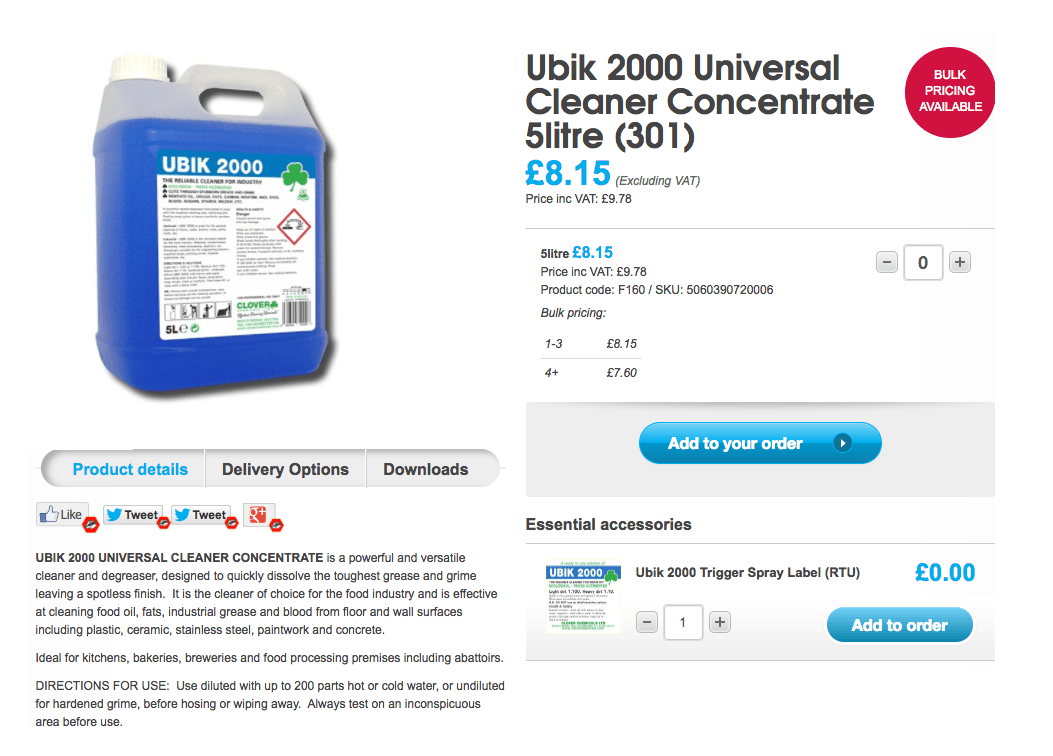
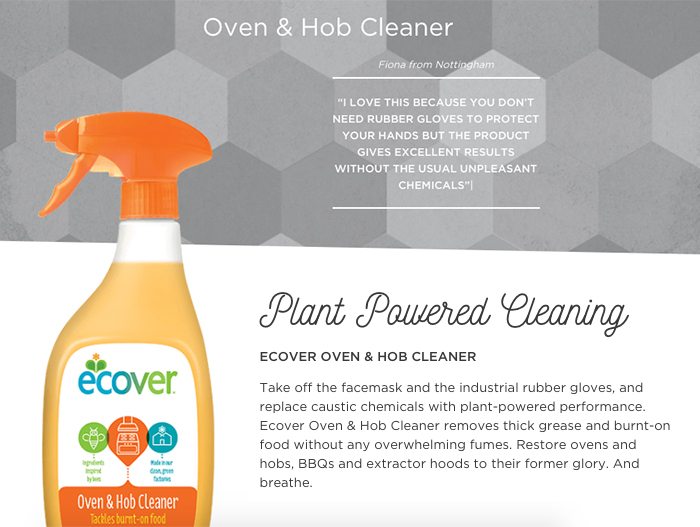
The first is for the catering industry, the second is for household use. So despite ultimately being for the same purpose – cleaning kitchens – the two have product descriptions that are constructed completely differently. You can clearly see that the concerns of the different audiences have been addressed in the product copy.
With this in mind, go back to your personas and think about:
- Who they are – are they even buying for themselves or someone else?
- What they need to get out of your product – what benefits does it need to deliver?
- Where they’re looking – is this on your own e-commerce store or is your product being considered amongst many on another marketplace like Amazon?
- When they’re shopping for it – is this a rush-job or a carefully-considered investment?
- Why they’re buying this product – what needs, aspirations and desires are they needing to fulfil?
Tell a story
Once you’ve got a strong handle on who you’re writing for, it’s time to crack out those story-telling skills.
Stories are the best way to connect with consumers – they’re the most powerful way to activate our brains, helping us connect emotionally. Emotion has been found to be the primary influencer of decision-making when it comes to evaluating brands and intention to buy products.
This can be useful whether you’re connecting with a B2C or B2B audience, despite the traditional understanding of B2B marketing as being less emotional.
Appeal to the senses, and to feelings like nostalgia, excitement, ease, adventure, relaxation, satisfaction and luxury. Here’s a perfect example of emotive story-telling through a product description:
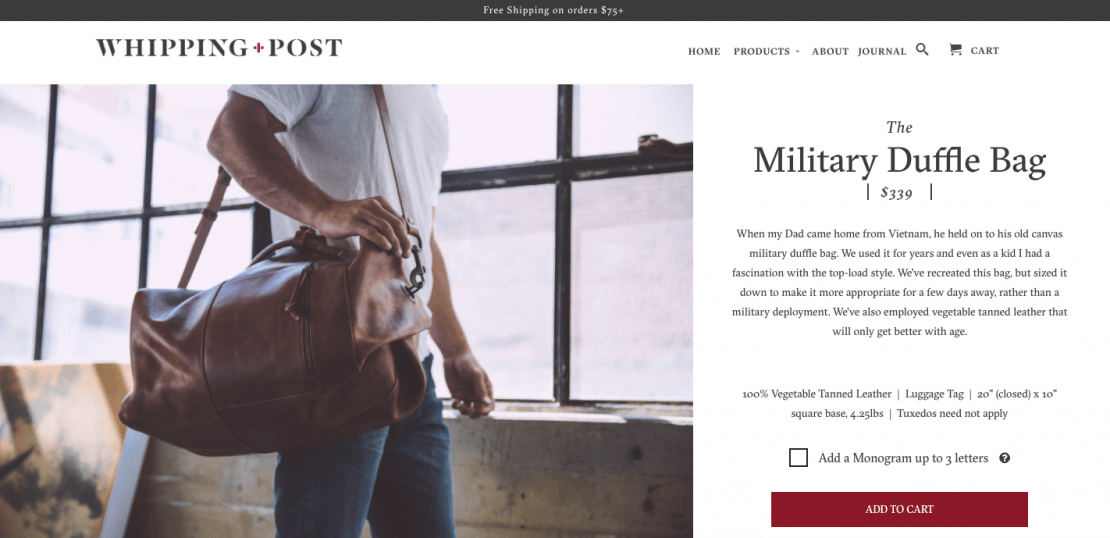
Compare to this far blander description for a very similar product:
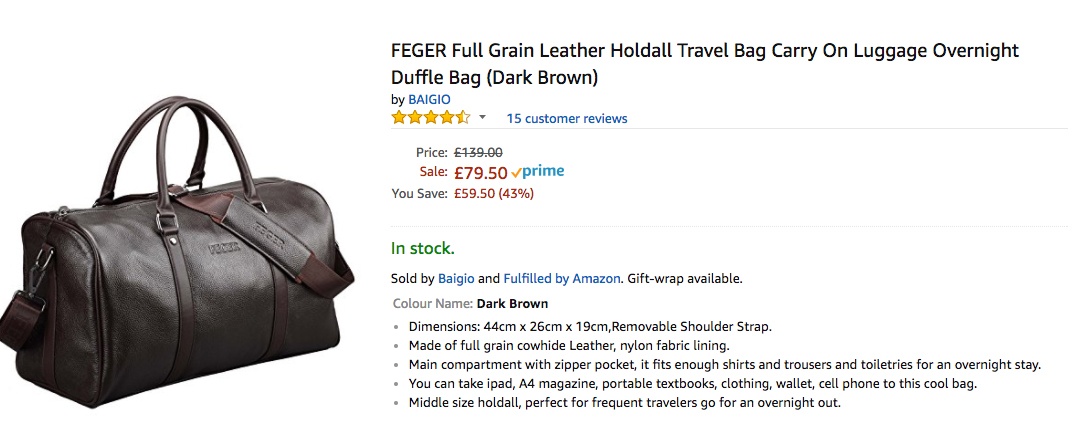
Which would you feel more drawn to?
If you’re anything like us, you probably said Whipping Post – they told a beautiful story that elevated a leather bag into a lifestyle item meriting a hefty pricetag.
However, it’s worth remembering the other part of the lesson – the context and persona. Whipping Post was selling to a shopper who had found their way onto the brand’s own e-commerce store. Baigio, on the other hand, is selling on Amazon – its page visitor had likely performed a site-search for the product and now the pressure is on to capture interest quickly and push features to a shopper who’s likely comparing on price, ratings and benefits. Sometimes you don’t have time to spin a yarn – but wherever you can, it changes the game.
Top tip: forget the manufacturer’s description – not only will you likely be duplicating content which will be an SEO drawback, but it’s targeted at the wrong audience – the seller, not the consumer, so will usually focus on generic specifications rather than creating a compelling story.
Emphasize benefits over features
Your story should include the benefits of your product. Your description, along with being emotive in some way, should therefore also showcase the benefits of this particular product over others like it.
The term ‘benefits’ is key here. It can be hard to get past the features of the product – its specifications, uses, design elements – your challenge is to spin them into benefits to contextualize all the elements of your product for the user.
So, instead of: ‘This 35cm x 25 cm x 8cm leather handbag comes with different size straps that clip on and off and a variety of pocket sizes.’
You get: ‘Whether you’re sliding your laptop in for your next meeting, packing your carry-on bag for a holiday or simply running around town, this stylish but durable Italian leather handbag is ready for anything. Choose from different size straps that snap into place to suit any wearer and any style.’
A great way to think about this is that you’re selling the outcome, rather than the process.
For instance, GoPro has a burst function that takes many photos in quick succession, but its copy focuses on the result: the ability to capture the moment.
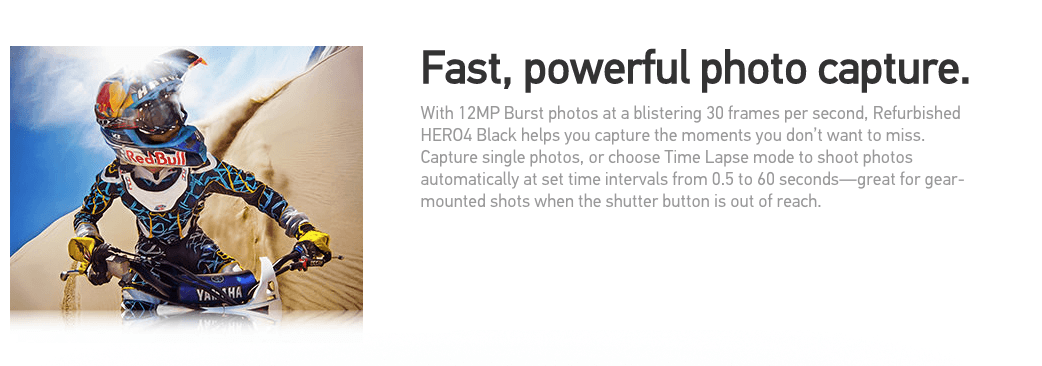
To make this easier, write out a list of all the features of your product and then turn each into a benefit.
For example, a feature would be a jacket made out of nylon – the benefit is that it’s quick-drying. The challenge here is to really think about why someone would need your product and to weave the elements of design into a great pitch that really connects with your target persona.
In writing descriptions, be as specific as possible and avoid overused words like ‘stunning’, ‘nice’, ‘excellent’, ‘high quality’, but instead demonstrate these attributes with memorable words and phrases.
Provide information succinctly
After you’ve created a compelling story that weaves in what the product will do for the user, it’s time to cut to the chase – to turn browsers into buyers, you need to give details.
Consider aspects like:
- Dimensions
- Colours available
- Materials
- Battery life
- Attachments included
- Place of manufacture
- Warranty or money-back guarantee
You can deliver this information (or more information, if your product is a complex one) in a variety of ways, such as with an FAQ (which can also bring SEO benefits, build trust and alleviate customer service burdens by heading off as many queries as possible).
What to do if your product is boring
We’ve all been there. Using emotive, exciting language is all well and good if your product is one that gets people excited. But not every product is a new iPhone.
Here, it’s even more important to emphasize the solution that your product delivers – while your customer might not get excited about the product, they might be thrilled at how much time, money or headaches it’ll save them.
And just because your product is perceived as boring doesn’t mean your description has to be – everyday products can be the perfect opportunity to add a sense of humour that will make the product memorable:
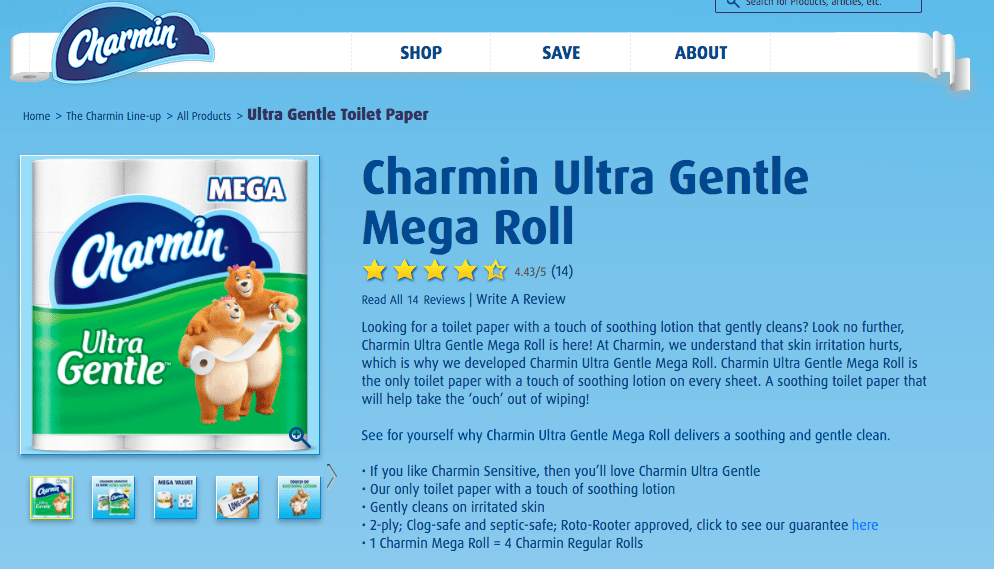
Most of all, be succinct
For any product, boring or not, Orwell’s advice to writers is always worth bearing in mind (he probably wasn’t thinking about product descriptions, but it still works):
- Never use a metaphor, simile, or other figures of speech which you are used to seeing in print.
- Never use a long word where a short one will do.
- If it is possible to cut a word out, always cut it out.
- Never use the passive where you can use the active.
- Never use a foreign phrase, a scientific word, or a jargon word if you can think of an everyday English equivalent.
- Break any of these rules sooner than say anything outright barbarous.
A note on jargon: if the product you’re advertising is particularly technical, it can be difficult to veer away from away from using jargon. However, it’s important to keep it to a minimum – the exception to this rule is if you have a particularly informed audience who understands – and expects – that terminology.
Make your descriptions work for SEO
The buyers most likely to convert are the ones who went out hunting for your product – so how can your product description help get you in their crosshairs?
Long-tail keywords
Product descriptions are an ideal place to target long-tail SEO: when people are looking for something very specific, your optimized page can be there to meet their needs. Consider H1 and H2 title tags, which can be very descriptive without appearing robotic (‘Hot pink cocktail party dress – perfect for a wedding’, for example, instead of ‘Pink dress’).
Step into your user’s shoes and think about what they are looking for and how and why they might be searching.
Image alt tags
It’s easy to forget to tag your images with alternative text, but it can be a great SEO enhancer, as well as being best practice in case your images don’t load. Use this as an opportunity for relevant keywords.
User-generated content
Including a space for user reviews on your product page might be useful for several reasons:
- Fresh content keeps the page updated, which is good for algorithms
- Boosts natural keywords, backlinks and internal links
- User reviews also create social proof and help build trust.
Rich content
Product pages can act as a hub for all kinds of information on the product – reviews and other social proof, product guides, FAQs, links to other related products and longer form content. These elements assist the user in making their decision but also contribute to your SEO strategy.
Laying out your product descriptions
It’s important not to get so caught up weaving a beautiful story in your product description that you forget to make it readable within your product page. Customers who were surveyed for the Salsify study indicated that page features – particularly bullets, images, videos and reviews – were much more likely to convince them than price alone.
Make it scannable
Consider this page for an Innocent smoothie. It uses just two colours, plenty of space, and ticks to subtly underline the health features of the product. There’s not much copy and it’s easy to read, with the product’s offering (reducing tiredness, boosting vitamins) highlighted in a different colour and the features list bolded to draw the eye.
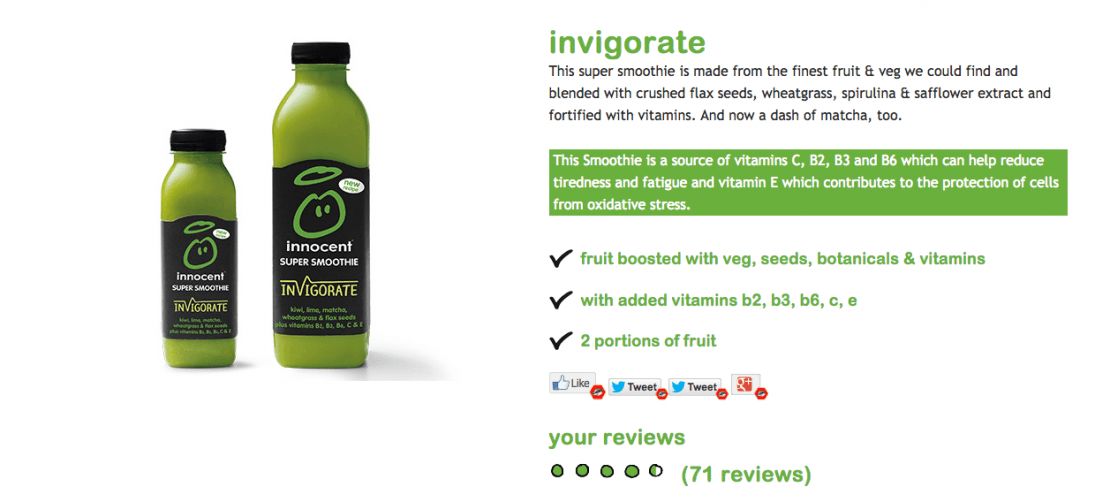
Optimize for mobile
With over half of retail traffic in the UK browsing via a mobile device, and half of online sales completed via mobile, it’s crucial that your page looks good – and works – on mobile. A US study found that 40% of users would switch to a competitor after a bad mobile experience, yet 84% of consumers had had difficulty completing a mobile transaction.
Images
Images do a lot of the heavy lifting when it comes to communicating the look and feel of the product. Skinner Auctions ran an A/B test blowing up the images in their online catalogue by 28%, from 250 pixels across to 350 pixels across. The larger image enticed 63% more visitors to click to start the bidding process.
The same Salsify study we mentioned earlier reports that consumers like to see at least three images of the product – so make sure you capture the product from all angles.
Video
According to Internet Retailer, online housewares store StacksAndStacks saw that customers were 144% more likely to add a product to their cart after watching a video.
A well-made video that demonstrates the product in use can help communicate benefits and complex ideas and allows consumers to picture themselves using the product.
The E-commerce copywriter’s checklist
OK, now you’re all ready to start turning your product descriptions into works of art that really move the needle. Go back to your personas; everything that you write has to be shaped around them and their motivation for purchasing
- Weave a story that elicits an emotion
- Go for benefits over features
- Be scannable and easy to read at a glance Do a top-to-tail SEO audit Make sure the page looks good and works on mobile Rich content has an impact on the bottom line – use it wherever it’s worth doing so
Ready to turn more browsers into buyers? We can help you get your visitors across the finish line.